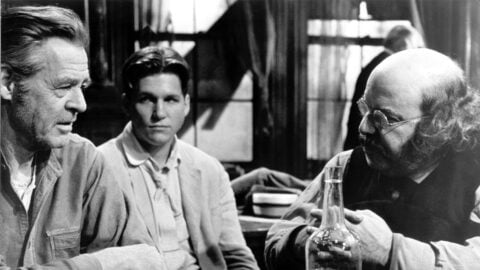Review: The Last Voyage of the Demeter
This article appeared in the August 17, 2023 edition of The Film Comment Letter, our free weekly newsletter featuring original film criticism and writing. Sign up for the Letter here.

The Last Voyage of the Demeter (André Øvredal, 2023)
Vampires know from purgatory: trapped somewhere between life and death, their plight is nothing less than an existential endurance test, with scattered perks and plenty of downtime. The 20-year journey of André Øvredal’s new supernatural thriller The Last Voyage of the Demeter through the Stygian depths of development hell gives the film a grimly self-reflexive dimension. It asks: how long can you be trapped in a confined space with Dracula before you go mad and/or give up the fight?
Although its initial script sold in 2003, during the same pop-cultural epoch in which Buffy the Vampire Slayer and Twilight sought to contemporize (if not defang) Victorian archetypes of well-monied bloodsuckers and their swooning conquests, Demeter was always intended as a throwback. Not only to the 19th-century ambience of Bram Stoker’s Dracula, but also to the text itself, specifically as an extrapolation of the enigmatic, epistolary chapter about the Count’s surreptitious trip from Romania to London. In the book, Stoker elides the gory details by which an entire company of seamen are picked off over the course of four stormy weeks while their enemy lurks below decks; “only God can guide us in the fog, which seems to move with us,” scribbles the ship’s captain, “and God seems to have deserted us.” For Øvredal, the mandate is to fill in the blanks—ideally with imagery original enough to offset the predetermined shape of the narrative.
On this count, The Last Voyage of the Demeter scores a split decision. Its canted angles and creature design nod toward the Expressionist vision of F.W. Murnau’s Nosferatu (1922), even as they point up the startling redundancy of the enterprise. With all due respect to the professionally malleable Spanish actor Javier Botet, whose stage and screen resume includes Frankenstein’s Monster, the Egyptian god of chaos, and the supernatural Slender Man, his embodiment of the most iconic movie fiend has nothing on Max Shreck’s nightmare-fuel incarnation. Not that Botet gets to give much of a performance beyond the odd rictus grin. In order for story writer Bragi Schut Jr.’s ocean-bound conceit to work, Dracula has to stay in goblin mode for the entire run time, undermining the character’s enduring mix of seductiveness and savagery and rendering him him little more than a fleet, mobile graphic element within a painstakingly grayscale mise en scène.
For a while—let’s say the first 30 minutes or so—the mix of hearty nautical-adventure conventions and brooding ominousness works, especially if you’ve got some goodwill stored up for old-school Val Lewtonism; anyone who can resist a sequence where scraggly, nervous Eastern European villagers plead with British visitors about the importance of seeking shelter before nightfall is made of stronger stuff than I. There are also a couple of nice casting decisions, starting with the omnipresent and excellently cadaverous David Dastmalchian as the cargo ship’s first mate, Wojchek, who becomes a grumpy, glowering foil to Corey Hawkins’s Cambridge-educated med student, Clemens. The latter’s race makes him an outsider even as his skill for blood transfusions renders him indispensable; as the film goes on, he becomes the halting yet resolute voice of capital-R reason in the face of the unknown.
“It is only a beast,” proclaims Clemens of the Demeter’s stowaway, simultaneously whistling in the dark and pointing toward the fascinating notions about biology, infection, and survival that illuminated Stoker’s novel. Like Mary Shelley’s opus, subtitled The Modern Prometheus, Dracula staged its bloody skirmishes between conflicting religious and cultural traditions in the shadow of modernity. The coexistence in the the story of supernatural elements with emerging scientific—and psychotherapeutic—techniques (i.e., Van Helsing’s utilization of Freudian hypnosis as a tool alongside garlic, stakes, and crucifixes) gave the action a certain tension, as did the tale’s implicit commentary on class stratification. For Stoker, Dracula was, more than anything, a vile and crafty interloper—an Old World aristocrat looking to expand his empire by becoming a landowner in industrialized London.
The idea of a weakened, emaciated Dracula in secret exile from his Carpathian kingdom—and forced to subsist on livestock and rats until he regains his world-beating strength—is rich with implication, but Schut Jr. and his writing partner Zak Olkewicz never quite tap the vein. Instead, they remain straitjacketed by canon, contriving scenes mostly to serve as connective tissue between the novel’s elliptical narrational clusters. The stuff they do come up with, meanwhile, quickly gets repetitive. With such intrinsic vampire-movie elements as seduction and suavity off the table, things get stuck in a humorless slasher-movie groove, to the point that it scarcely matters that Clint Eastwood veteran Tom Stern’s cinematography has a real sepulchral grandeur, or that Bear McCreary’s score hits the right Gothic notes. The best vampire movies lean in to doomed romanticism; they understand that you have to get the blood pumping before extracting it. The Last Voyage of the Demeter is gory but parched; it does just enough to whet our appetites without remotely slaking our thirst.
Adam Nayman is a critic, lecturer, and author based in Toronto. His latest book, David Fincher: Mind Games, is available from Abrams Books.







